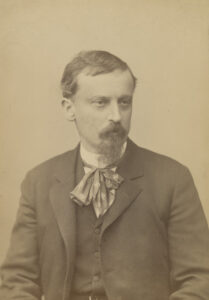Henryk Sienkiewicz
1846-1916
Henryk Sienkiewicz comes from a noble family and writes a number of great historical novels with more or less hidden references to Poland’s position as an occupied country.
The novels are widely read and have helped to propagate a common Polish identity and a number of myths about Poland, Christianity and European culture.
At the time of Sienkiewicz’s writing, Poland was divided between Austria, Germany and Russia, with the latter controlling the majority of Polish territory and waging a consistent fight against Polish culture.
Some of the most important works include:
Quo Vadis (1896) is set in Nero’s Rome and the theme is the persecution of Christians.
With Fire and Sword (1884) is part of a trilogy about Poland’s struggles with its neighbours in the 17th century, including the Ukrainian uprising and the Swedish attack on Poland.
The trilogy presents a Polish point of view, which is often contested, especially in Ukraine.

The novel describes the Teutonic Order’s (later Prussia) battles with Poland in the 14th and 15th centuries in a deliberately archaic artistic language that all Polish schoolchildren have to struggle with.
A key element is the Battle of Tannenberg in 1410, which plays a significant role in both Polish and German national self-understanding.
A teenage novel from 1911 about 20th century Egypt and East Africa and the relationship between smart and active boys and admiring girls.
It is an ethnocentric novel that clearly shows the superiority of the white race over Arabs and native Africans.
If you feel uncomfortable hearing about Pipi Longstocking’s father (who is a Negro chieftain), you’ll have to run far away if you come across this book.
In Poland, it is still read in schools, usually just to be reproduced uncritically.
All of the novels have been made into films, most of them several times, which, in addition to compulsory reading in school, has helped to shape the Polish self-image.
In the interest of truth, it should be mentioned that in some schools Sienkiewicz is read critically, but the Polish school system is characterised by a huge amount of text reading and there is rarely room for critical analysis.
Please send an email to m@hardenfelt.pl if you would like an English-speaking tour guide to show you the most important places in Warsaw.
